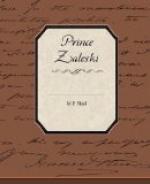waved line; and as a waved line it was originally
written, and was the character by which
a stream
of running water was represented in writing; indeed
it only owes its name to the fact that when the lips
are pressed together, and “m” uttered by
a continuous effort, a certain resemblance to the
murmur of running water is produced. The longer
waved line in the diagram I therefore took to represent
“m”; and it at once followed that the
shorter meant “n,” for no two letters of
the commoner European alphabets differ only in length
(as distinct from shape) except “m” and
“n”, and “w” and “v”;
indeed, just as the French call “w” “double-ve,”
so very properly might “m” be called “double-en.”
But, in this case, the longer not being “w,”
the shorter could not be “v”: it
was therefore “n.” And now there only
remained the heart and the triangle. I was unable
to think of any letter that could ever have been intended
for the picture of a heart, but the triangle I knew
to be the letter #A.# This was originally written
without the cross-bar from prop to prop, and the two
feet at the bottom of the props were not separated
as now, but joined; so that the letter formed a true
triangle. It was meant by the primitive man to
be a picture of his primitive house, this house being,
of course, hut-shaped, and consisting of a conical
roof without walls. I had thus, with the exception
of the heart, disentangled the whole, which then (leaving
a space for the heart) read as follows:
{ ss
‘mn { anan ... san.’
{ cc
But ‘c’ before ‘a’ being never
a sibilant (except in some few so-called ‘Romance’
languages), but a guttural, it was for the moment discarded;
also as no word begins with the letters ’mn’—except
‘mnemonics’ and its fellows—I
concluded that a vowel must be omitted between these
letters, and thence that all vowels (except ‘a’)
were omitted; again, as the double ‘s’
can never come after ‘n’ I saw that either
a vowel was omitted between the two ‘s’s,’
or that the first word ended after the first ‘s.’
Thus I got
‘m ns sanan... san,’
or, supplying the now quite obvious vowels,
‘mens sana in... sano.’
The heart I now knew represented the word ‘corpore,’
the Latin word for ‘heart’ being ‘cor,’
and the dot—showing that the word as it
stood was an abbreviation—conclusively
proved every one of my deductions.
’So far all had gone flowingly. It was
only when I came to consider the central figures that
for many days I spent my strength in vain. You
heard my exclamation of delight and astonishment when
at last a ray of light pierced the gloom. At
no time, indeed, was I wholly in the dark as to the
general significance of these figures, for I
saw at once their resemblance to the sepulchral reliefs
of classical times. In case you are not minutely
acquainted with the technique of these stones,
I may as well show you one, which I myself removed
from an old grave in Tarentum.’




